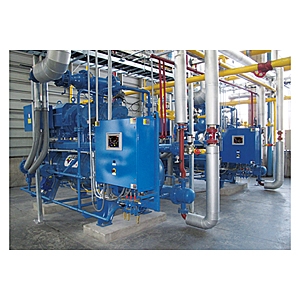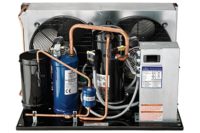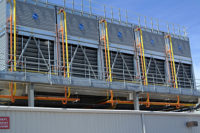Condensers are generally applied to convert discharge vapors into liquid refrigerant by rejecting waste heat (the heat absorbed by refrigerant in producing a cooling  effect) to the atmosphere. Multiple resources are consumed by evaporative condensers in rejecting the heat. Water is vaporized and bleeds off to remove concentrated minerals, chemicals are used to reduce scaling and electricity is consumed to power condenser fans and pumps.
effect) to the atmosphere. Multiple resources are consumed by evaporative condensers in rejecting the heat. Water is vaporized and bleeds off to remove concentrated minerals, chemicals are used to reduce scaling and electricity is consumed to power condenser fans and pumps.
The magnitude of waste heat dissipated by condensers is substantial, but the low quality of the heat (75°F to 90°F) renders it relatively useless in satisfying food and beverage processing plant heat loads. Processors consume significant volumes of hot water (140°F to 145°F) for sanitation and other duties, heated by the consumption of fossil fuel in boilers and hot water heaters. Capturing the waste heat from refrigeration and putting it to beneficial use delivers considerable savings in fossil fuel consumption and a reduction in associated CO2 emissions.
Recent advancements of industrial heat pumps—applying developments in high pressure compressor and condenser technologies—have enabled the ability to convert low-grade waste heat from refrigeration to high-grade, high-temperature, usable heat. Industrial heat pumps deliver these benefits while serving the same function as conventional condensers, converting discharge vapors into liquid refrigerant without using the resources consumed by evaporative condensers.
Industrial heat pumps are being retrofitted into food and beverage processing plants to satisfy a multitude of heat loads, including hot water for sanitizing in meat and poultry processing, clean-in-place (CIP) and process heat in chocolate factories, pasteurizing and CIP in dairy facilities, washing and blanching produce, warming bottles in beverage plants and heating greenhouses.


